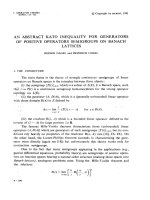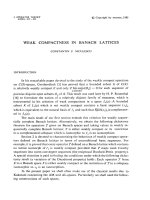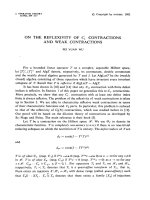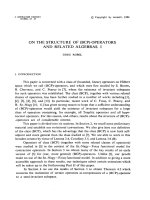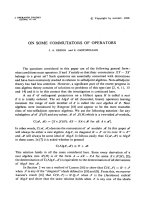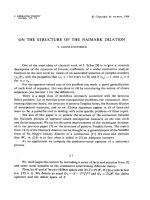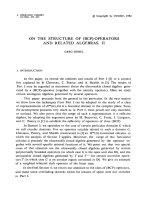Báo cáo toán học: "On oriented arc-coloring of subcubic graphs" ppsx
Bạn đang xem bản rút gọn của tài liệu. Xem và tải ngay bản đầy đủ của tài liệu tại đây (149.16 KB, 13 trang )
On oriented arc-coloring of subcubic graphs
Alexandre Pinlou
E-mail:
LaBRI, Universit´e Bordeaux 1
351 Cours de la Lib´eration
33405 Talence Cedex, France
Submitted: Jan 17, 2006; Accepted: Aug 2, 2006; Published: Aug 7, 2006
Mathematics Subject Classification: 05C15
Abstract
A homomorphism from an oriented graph G to an oriented graph H is a mapping
ϕ from the set of vertices of G to the set of vertices of H such that
−−−−−−→
ϕ(u)ϕ(v)isan
arc in H whenever
−→
uv is an arc in G. The oriented chromatic index of an oriented
graph G is the minimum number of vertices in an oriented graph H such that there
exists a homomorphism from the line digraph LD(G)ofG to H (Recall that LD(G)
is given by V (LD(G)) = A(G)and
−→
ab ∈ A(LD(G)) whenever a =
−→
uv and b =
−→
vw).
We prove that every oriented subcubic graph has oriented chromatic index at most
7 and construct a subcubic graph with oriented chromatic index 6.
Keywords: Graph coloring, oriented graph coloring, arc-coloring, subcubic graphs.
1 Introduction
We consider finite simple oriented graphs, that is digraphs with no opposite arcs. For an
oriented graph G,wedenotebyV (G) its set of vertices and by A(G)itssetofarcs.
In [2], Courcelle introduced the notion of vertex-coloring of oriented graphs as follows:
an oriented k-vertex-coloring of an oriented graph G is a mapping ϕ from V (G)toaset
of k colors such that (i) ϕ(u) = ϕ(v) whenever
−→
uv is an arc in G,and(ii) ϕ(u) = ϕ(x)
whenever
−→
uv and
−→
wx are two arcs in G with ϕ(v)=ϕ(w). The oriented chromatic number
of an oriented graph G, denoted by χ
o
(G), is defined as the smallest k such that G admits
an oriented k-vertex-coloring.
Let H and H
be two oriented graphs. A homomorphism from H to H
is a mapping
ϕ from V (H)toV (H
) that preserves the arcs:
−−−−−−→
ϕ(u)ϕ(v) ∈ A(H
) whenever
−→
uv ∈ A(H).
An oriented k-vertex-coloring of G can be equivalently defined as a homomorphism ϕ from
the electronic journal of combinatorics 13 (2006), #R69 1
G to H,whereH is an oriented graph of order k. The existence of such a homomorphism
from G to H is denoted by G → H. The graph H will be called color-graph and its vertices
will be called colors, and we will say that G is H-colorable. The oriented chromatic number
can be then equivalently defined as the smallest order of an oriented graph H such that
G → H.
Oriented vertex-colorings have been studied by several authors in the last past years
(see e.g. [1, 3, 5] or [7] for an overview).
One can define oriented arc-colorings of oriented graphs in a natural way by saying
that, as in the undirected case, an oriented arc-coloring of an oriented graph G is an
oriented vertex-coloring of the line digraph LD(G)ofG (Recall that LD(G)isgivenby
V (LD(G)) = A(G)and
−→
ab ∈ A(LD(G)) whenever a =
−→
uv and b =
−→
vw). We will say that
an oriented graph G is H-arc-colorable if there exists a homomorphism ϕ from LD(G)
to H and ϕ is then an H-arc-coloring or simply an arc-coloring of G. Therefore, an
oriented arc-coloring ϕ of G must satisfy (i) ϕ(
−→
uv) = ϕ(
−→
vw) whenever
−→
uv and
−→
vw are
two consecutive arcs in G,and(ii) ϕ(
−→
vw) = ϕ(
−→
xy) whenever
−→
uv,
−→
vw,
−→
xy,
−→
yz ∈ A(G)with
ϕ(
−→
uv)=ϕ(
−→
yz). The oriented chromatic index of G, denoted by χ
o
(G), is defined as the
smallest order of an oriented graph H such that LD(G) → H.
The notion of oriented chromatic index can be extended to undirected graphs as fol-
lows. The oriented chromatic index χ
o
(G) of an undirected graph G is the maximum of
the oriented chromatic indexes taken over all the orientations of G (an orientation of an
undirected graph G is obtained by giving one of the two possible orientations to every
edge of G).
In this paper, we are interested in oriented arc-coloring of subcubic graphs, that is
graphs with maximum degree at most 3.
Oriented vertex-coloring of subcubic graphs has been first studied in [4] where it was
proved that every oriented subcubic graph admits an oriented 16-vertex-coloring. In 1996,
Sopena and Vignal improved this result:
Theorem 1 [6] Every oriented subcubic graph admits an oriented 11-vertex-coloring.
It is not difficult to see that every oriented graph having an oriented k-vertex-coloring
admits a k-arc-coloring (from a k-vertex-coloring f,weobtainak-arc-coloring g by setting
g(
−→
uv)=f(u) for every arc
−→
uv). Therefore, every oriented subcubic graph admits an
oriented 11-arc-coloring.
We improve this bound and prove the following
Theorem 2 Every oriented subcubic graph admits an oriented 7-arc-coloring.
More precisely, we shall show that every oriented subcubic graph admits a homomor-
phism to QR
7
, a tournament on 7 vertices described in section 3.
Note that Sopena conjectured that every oriented connected subcubic graph admits
an oriented 7-vertex-coloring [4].
the electronic journal of combinatorics 13 (2006), #R69 2
This paper is organized as follows. In the next section, we introduce the main definitions
and notation. In section 3, we described the tournament QR
7
and give some properties
of this graph. Finally, Section 4 is dedicated to the proof of Theorem 2.
2 Definitions and notation
In the rest of the paper, oriented graphs will be simply called graphs.ForagraphG
and a vertex v of G,wedenotebyd
−
G
(v) the indegree of v,byd
+
G
(v) its outdegree and
by d
G
(v) its degree. A vertex of degree k (resp. at most k,atleastk) will be called a
k-vertex (resp.
≤
k-vertex,
≥
k-vertex). A source vertex (or simply asource) is a vertex
v with d
−
(v)=0andasink vertex (or simply a sink ) is a vertex v with d
+
(v)=0. A
source (resp. sink) of degree k will be called a k-source (resp. a k-sink).
We denote by N
+
G
(v), N
−
G
(v)andN
G
(v) respectively the set of successors of v,the
set of predecessors of v and the set of neighbors of v in G.Themaximum degree and
minimum degree of a graph G are respectively denoted by ∆(G)andδ(G).
We denote by
−→
uv the arc from u to v or simply uv whenever its orientation is not
relevant (therefore uv =
−→
uv or uv =
−→
vu).
For a graph G and a vertex v of V (G), we denote by G \ v the graph obtained from G
by removing v together with the set of its incident arcs; similarly, for an arc a of A(G),
G \ a denotes the graph obtained from G by removing a. These two notions are extended
to sets in a standard way: for a set of vertices V
, G \ V
denotes the graph obtained from
G by successively removing all vertices of V
and their incident arcs, and for a set of arcs
A
, G \ A
denotes the graph obtained from G by removing all arcs of A
.
Let G be an oriented graph and f be an oriented arc-coloring of G. For a given vertex
v of G,wedenotebyC
+
f
(v)andC
−
f
(v) the outgoing color set of v (i.e. the set of colors
of the arcs outgoing from v) and the incoming color set of v (i.e. the set of colors of the
arcs incoming to v), respectively.
The drawing conventions for a configuration are the following: a vertex whose neigh-
bors are totally specified will be black (i.e. vertex of fixed degree), whereas a vertex whose
neighbors are partially specified will be white. Moreover, an edge will represent an arc
with any of its two possible orientations.
3 Some properties of the tournament QR
7
For a prime p ≡ 3 (mod 4), the Paley tournament QR
p
is defined as the oriented graph
whose vertices are the integers modulo p andsuchthat
−→
uv is an arc if and only if v − u
is a non-zero quadratic residue of p.
For instance, let us consider the tournament QR
7
with V (QR
7
)={0, 1, ,6} and
−→
uv ∈ A(QR
7
) whenever v − u ≡ r (mod 7) for r ∈{1, 2, 4}.
This graph has the two following useful properties [1]:
(P
1
) Every vertex of QR
7
has three successors and three predecessors.
the electronic journal of combinatorics 13 (2006), #R69 3
s
1
s
n
s
3
s
2
s
n
s
1
t
1
s
4
s
4
s
3
s
2
s
3
s
3
s
n
s
2
s
1
s
n
s
1
s
2
t
1
t
2
s
4
Figure 1: Two special cycles
(P
2
) For every two distinct vertices u and v, there exists four vertices w
1
,w
2
,w
3
and w
4
such that:
•
−−→
uw
1
∈ A(QR
7
)and
−−→
vw
1
∈ A(QR
7
);
•
−−→
uw
2
∈ A(QR
7
)and
−−→
w
2
v ∈ A(QR
7
);
•
−−→
w
3
u ∈ A(QR
7
)and
−−→
w
3
v ∈ A(QR
7
);
•
−−→
w
4
u ∈ A(QR
7
)and
−−→
vw
4
∈ A(QR
7
).
4 Proof of Theorem 2
Let G be an oriented subcubic graph and C be a cycle in G (C is a subgraph of G). A
vertex u of C is a transitive vertex of C if d
+
C
(u)=d
−
C
(u) = 1 (therefore 2 ≤ d
G
(u) ≤ 3).
AcycleC in G is a special cycle if and only if:
(1) every non-transitive vertex of C is a 2-source or a 2-sink in G;
(2) C has either exactly 1 transitive vertex or exactly 2 transitive vertices, and in this
case, both transitive vertices have the same orientation on C.
Figure 1 shows two special cycles; the first one has exactly 1 transitive vertex while
the second has exactly 2 transitive vertices oriented in the same direction. Vertices s
i
, s
j
and t
k
are respectively the sinks, sources, and transitive vertices of the special cycles.
Remark 3 Every 2-source (resp. 2-sink) in a special cycle C is necessarily adjacent to a
2-sink (resp. 2-source). This directly follows from the fact that C does not contain two
transitive vertices oriented in opposite direction.
We shall denote by SS
G
(C) the set of 2-sources and 2-sinks of the cycle C in G.
Remark 4 Note that a special cycle may only be connected to the rest of the graph by
its transitive vertices (see Figure 2 for an example).
the electronic journal of combinatorics 13 (2006), #R69 4
s
3
s
1
s
1
s
3
s
n
s
4
s
4
s
n
t
1
s
2
s
2
s
n
s
1
s
1
s
2
s
3
t
2
s
2
s
4
s
3
t
1
s
n
s
1
s
1
t
2
s
4
s
3
s
3
s
2
s
2
s
n
s
n
t
1
Figure 2: Graphs with a special cycle
A QR
7
-arc-coloring f of an oriented subcubic graph G is good if and only if :
• for every 2-source u, |C
+
f
(u)| =1,
• for every 2-sink v, |C
−
f
(v)| =1.
Note that if a subcubic graph G admits a good QR
7
-arc-coloring, then for every 2-
vertex v of G, |C
+
f
(v)|≤1and|C
−
f
(v)|≤1.
We first prove the following:
Theorem 5 Every oriented subcubic graph with no special cycle admits a good QR
7
-arc-
coloring.
We define a partial order ≺ on the set of all graphs. Let n
2
(G)bethenumberof
≥
2-vertices of G. For any two graphs G
1
and G
2
, G
1
≺ G
2
if and only if at least one of
the following conditions holds:
• G
1
is a proper subgraph of G
2
;
• n
2
(G
1
) <n
2
(G
2
).
Note that this partial order is well-defined, since if G
1
is a proper subgraph of G
2
,then
n
2
(G
1
) ≤ n
2
(G
2
). The partial order ≺ is thus a partial linear extension of the subgraph
poset.
In the rest of this section, let H a be counter-example to Theorem 5 which is minimal
with respect to ≺.
We shall show in the following lemmas that H does not contain some configurations.
the electronic journal of combinatorics 13 (2006), #R69 5
In all the proofs which follow, we shall proceed similarly. We suppose that H con-
tains some configurations and, for each of them, we consider a reduction H
of H with
no special cycle such that H
≺ H. Therefore, due to the minimality of H, there exists a
good QR
7
-arc-coloring f of H
. The coloring f is a partial good QR
7
-arc-coloring of H,
that is an arc-coloring of some subset S of A(H) and we show how to extend it to a good
QR
7
-arc-coloring of H. This proves that H cannot contain such configurations.
We will extensively use the following proposition:
Proposition 6 Let
−→
G be an oriented graph which admits a good QR
7
-arc-coloring. Let
←−
G be the graph obtained from
−→
G by giving to every arc its opposite direction. Then,
←−
G
admits a good QR
7
-arc-coloring.
Proof:Letf be a good QR
7
-arc-coloring of
−→
G. Consider the coloring f
: V (QR
7
) →
A(
←−
G) defined by f
(
−→
uv)=6− f(
−→
vu).
It is easy to see that for every arc
−→
uv ∈ A(QR
7
), we have
−→
xy ∈ A(QR
7
) for x =6− v
and y =6− u. Moreover, the two incident arcs to a 2-source (or a 2-sink) will get the
same color by f
since they got the same color by f.
Therefore, when considering good QR
7
-arc-coloring of an oriented graph G,wemay
assume that one arc in G has a given orientation.
The following remark will be extensively used in the following lemmas :
Remark 7 Let G be a graph with no special cycle and A ⊆ A(G) be an arc set. If the
graph G
= G \ A contains a special cycle C, then at least one of the vertices incident
to A is a 2-source or a 2-sink in G
and belongs to V (C), since otherwise C would be a
special cycle in G.
Lemma 8 The graph H is connected.
Proof: Suppose that H = H
1
H
2
(disjoint union). We have H
1
≺ H and H
2
≺ H.
The graphs H
1
and H
2
contain no special cycle and then, by minimality of H, H
1
and
H
2
admits good QR
7
-arc-colorings f
1
and f
2
respectively that can easily be extended to
a good QR
7
-arc-coloring f = f
1
∪ f
2
of H.
Lemma 9 The graph H contains no 3-source and no 3-sink.
Proof: By Proposition 6, we just have to consider the 3-source case. Let u be a 3-source
in H and H
be the graph obtained from H by splitting u into three 1-vertices u
1
,u
2
,u
3
.
We have H
≺ H since n
2
(H
)=n
2
(H) − 1. Any good QR
7
-arc-coloring of H
is clearly
a good QR
7
-arc-coloring of H.
Lemma 10 The graph H contains no 1-vertex.
the electronic journal of combinatorics 13 (2006), #R69 6
Proof:Letu
1
be a 1-vertex in H, v be its neighbor and N
H
(v)={u
i
, 1 ≤ i ≤ d
H
(v)}.
By Proposition 6, we may assume
−→
u
1
v ∈ A(H). We consider three subcases.
1. d
H
(v)=1.
By Lemma 8, H =
−→
u
1
v and obviously, H admits a good QR
7
-arc-coloring.
2. d
H
(v)=2.
Let H
= H \ u
1
;wehaveH
≺ H and H
contains no special cycle by remark 7. By
minimality of H, H
admits a good QR
7
-arc-coloring f that can easily be extended
to H:ifv is a 2-sink, we set f(
−→
u
1
v)=f(
−→
u
2
v); otherwise, we have three available
colors for f(
−→
u
1
v) by Property (P
1
).
3. d
H
(v)=3.
Let H
= H \ u
1
;wehaveH
≺ H.
If H
contains no special cycle then, by minimality of H, H
admits a good QR
7
-
arc-coloring f such that |C
+
f
(v)|≤1. The coloring f can then be extended to H
since we have three available colors to set f(
−→
u
1
v) by property (P
1
).
If H
contains a special cycle C, v ∈ C and v is a 2-source in H
by Remark 7
and Lemma 9. We may assume w.l.o.g. that u
2
isa2-sinkbyRemark3. Let
N
H
(u
2
)={v,x} and H
= H \{
−→
vu
2
,
−→
u
1
v}.WehaveH
≺ H and H
contains no
special cycle by Remark 7. By minimality of H, H
admits a good QR
7
-arc-coloring
f that can be extended to H:wesetf(
−→
vu
2
)=f(
−→
xu
2
), and we have at least one
available color for f(
−→
u
1
v) by Property (P
2
).
Recall that a bridge in a graph G is an edge whose removal increases the number of
components of G.
Lemma 11 The graph H contains no bridge.
Proof: Suppose that H contains a bridge uv.LetH \uv = H
1
H
2
.Fori =1, 2, consider
H
i
= H
i
+uv. By Lemma 10, uv is not a dangling arc in H.MoreoverH
i
≺ H for i =1, 2.
Clearly, the graphs H
1
and H
2
have no special cycle and therefore, by minimality of H,
they admit good QR
7
-arc-colorings f
1
and f
2
respectively. By cyclically permuting the
colors of f
2
if necessary, we may assume that f
1
(uv)=f
2
(uv). The mapping f = f
1
∪ f
2
is then clearly a good QR
7
-arc-coloring of H.
Lemma 12 The graph H contains no 2-sink adjacent to a 2-source.
Proof: Suppose that H contains a 2-sink v adjacent to a 2-source w.LetN(v)={u, w}
and N(w)={v, x}.SinceH contains no special cycle, u and x are distinct vertices and
−→
xu /∈ A(H).
the electronic journal of combinatorics 13 (2006), #R69 7
y
w
v
3
= v
4
x
v
2
v
1
u
(a)
z
wx
v
2
v
1
y
v
4
v
3
u
(b)
Figure 3: Configurations of Lemma 14
Let H
be the graph obtained from H \{v,w} by adding
−→
ux (if it did not already
belong to A(H)). We have H
≺ H since n
2
(H
) ≤ n
2
(H) − 2. Since the vertices u
and x are neither 3-sources nor 3-sinks in H by Lemma 9, they are neither 2-sources
nor 2-sinks in H
and therefore, by Remark 7, H
contains no special cycle. Hence, by
minimality of H, H
admits a good QR
7
-arc-coloring f
that can be extended to H by
setting f(
−→
uv)=f (
−→
wv)=f(
−→
wx)=f (
−→
ux).
Lemma 13 Every 2-source (resp. 2-sink) of H is adjacent to a vertex v with d
+
(v)=2
(resp. d
−
(v)=2).
Proof: Suppose that H contains a 2-source u adjacent to two vertices v and w such
that d
+
(v) =2andd
+
(w) = 2 (by Proposition 6, it is enough to consider this case).
Let H
= H \ u; by hypothesis and by Lemmas 9 and 12, the vertices v and w are such
that d
+
H
(v)=d
−
H
(v)=d
+
H
(w)=d
−
H
(w) = 1. Therefore, the graph H
contains no
special cycle by Remark 7. By minimality of H, H
admits a good QR
7
-arc-coloring f
that can be extended to H in such a way that f(
−→
uu
1
)=f(
−→
uu
2
) thanks to Property (P
2
).
Recall that we denote by SS
G
(C) the set of 2-sources and 2-sinks of the cycle C in G.
Lemma 14 Let u be a vertex of H and H
= H \ u. Then H
does not contain a special
cycle C with |N
H
(u) ∩ SS
H
(C)| =1.
Proof:Letv
1
∈ N(u) and w.l.o.g., suppose that H
= H \ u contains a special cycle C
such that N
H
(u) ∩ SS
H
(C)={v
1
};byRemark7,v
1
is a 2-source or a 2-sink in H
and
by Proposition 6 we may assume w.l.o.g. that v
1
is a 2-source.
By Remark 3, v
1
is adjacent to a 2-sink v
2
. By Lemma 12, the only pair of adjacent
2-source and 2-sink in H
is v
1
,v
2
. Therefore, we have 3 ≤|C|≤4. Let V (C)=
{v
1
,v
2
,v
3
,v
4
} and v
3
= v
4
if |C| =3. Moreoverv
3
and v
4
are necessarily two transitive
vertices of C. Furthermore, we have
−→
yv
3
∈ A(H) by Lemma 13 and
−→
uv
1
∈ A(H)by
Lemma 9. Then, we have only two possible configurations, depicted in Figure 3.
the electronic journal of combinatorics 13 (2006), #R69 8
• If |C| = 3 (see Figure 3(a)), consider H
1
= H \
−−→
v
1
v
2
. This graph contains no special
cycle by Remark 7 and we have H
1
≺ H. By minimality of H, H
1
admits a good
QR
7
-arc-coloring f that can be extended to H: we first erase f (
−−→
v
1
v
3
); then, we can
set f(
−−→
v
1
v
2
)=f(
−−→
v
3
v
2
) thanks to Property (P
2
) and then we have one available color
for f(
−−→
v
1
v
3
) by Property (P
2
)sincef(
−→
uv
1
) = f(
−−→
v
3
v
2
).
• If |C| = 4 (see Figure 3(b)), consider the graph H
2
= H \ v
2
.WehaveH
2
≺ H.
– If H
2
contains no special cycle, by minimality of H, H
2
admits a good QR
7
-
arc-coloring f that can be extended to H in such a way that f(
−−→
v
3
v
2
)=f(
−−→
v
1
v
2
)
thanks to Property (P
2
)sincef(
−−→
v
4
v
3
)=f(
−→
yv
3
).
– Suppose now that H
2
contains a special cycle C
. ByRemark7,v
3
belong to
C
and by Remark 3, y is a 2-sink. By Lemma 12, the only pair of adjacent
2-source and 2-sink in H
is v
3
,y, and therefore |C
| is a special cycle of length
3 or 4. Suppose first that {u, v
1
,v
4
,v
3
,y}⊆V (C
); we thus have u = y,that
is a contradiction since by hypothesis N
H
(u) ∩ SS
H
(C)={v
1
}= {v
1
,v
3
}.
Therefore V (C
)={y,v
3
,v
4
,z},andthen
−→
zv
4
∈ A(H). If |C
| =3,wehave
y = z andinthiscase,thegraphH contains a bridge
−→
uv
1
that is forbidden by
Lemma 11. Therefore, we have |C
| =4andz is a transitive vertex of C
.
Consider in this case the graph H
3
= H \v
4
. This graph contains no special cy-
cle since the vertices v
1
and v
3
are two transitive 2-vertices oriented in opposite
directions. We have H
3
≺ H and therefore, by minimality of H, there exists
a good QR
7
-arc-coloring f of H
3
such that C
−
f
(v
1
)={c
1
},C
−
f
(v
2
)={c
2
} and
C
+
f
(y)=C
−
f
(z)={c
3
}. The mapping f can be extended to H as follows:
we can set f (
−−→
v
4
v
3
)=c
4
/∈{c
1
,c
3
} thanks to Property (P
1
). Then, by Prop-
erty (P
2
), we have one available color for f(
−−→
v
1
v
4
)sincec
1
= c
4
and one available
color for f(
−→
zv
4
)sincec
3
= c
4
.
Lemma 15 The graph H does not contain two adjacent 2-vertices.
Proof: Suppose that H contains two adjacent 2-vertices v and w.LetN(v)={u, w}
and N(w)={v, x} and H
= H \ v. By Lemma Remark 7 and 14, H contains no special
cycle. We have H
≺ H and by minimality of H, H
admits a good QR
7
-arc-coloring f.
We shall consider two cases depending on the orientation of the arcs incident to v and
w (by Proposition 6, we may assume that
−→
uv ∈ A(H)).
1. v is a 2-sink and w is a transitive vertex.
By Lemma 12, u is not a 2-source in H.Wehave|C
−
f
(u)|≤1andthen,wecanset
f(
−→
uv)=f(
−→
wv) thanks to Property (P
2
).
2. v and w are transitive vertices.
By the previous case, u is not a 2-source. We have |C
−
f
(u)|≤1. Thanks to
the electronic journal of combinatorics 13 (2006), #R69 9
u
u
2
u
1
(a)
u
1
u
2
u
(b)
u
u
1
u
2
(c)
u
u
2
u
1
(d)
u
1
u
u
2
u
5
u
4
u
3
(e)
u
1
u
u
2
u
3
u
4
v
(f)
Figure 4: Configurations of Lemma 16
Property (P
1
), we can set f (
−→
uv) = f(
−→
wx) and finally, we have one available color
for f(
−→
vw) by Property (P
2
)sincef(
−→
uv) = f(
−→
wx).
Lemma 16 The graph H contains no 2-vertex.
Proof: Suppose that H contains a 2-vertex u and let N(u)={u
1
,u
2
}. The vertices
u
1
and u
2
are 3-vertices by Lemma 15. By Proposition 6, we may assume w.l.o.g. that
−→
uu
1
∈ A(H). Let H
1
= H \ u;wehaveH
1
≺ H.
If H
1
contains no special cycle, then by minimality of H, H
1
admits a good QR
7
-arc-
coloring f of H
1
that can be extended to H as follows. If u is a 2-source , we can set
f(
−→
uu
1
)=f(
−→
uu
2
) thanks to Property (P
2
)since|C
+
f
(u
1
)|≤1and|C
+
f
(u
2
)|≤1. If u is a
transitive vertex, we can set f(
−→
uu
1
) /∈ C
−
f
(u
2
) thanks to Property (P
1
) and then we have
one available color for f(
−→
u
2
u) by Property (P
2
).
Suppose now that H
1
contains a special cycle C. By Lemma 14, u
1
and u
2
belongs to
C and at least one of them is a 2-source or a 2-sink.
Suppose first that u
1
is a 2-source in H
1
and u
2
is neither a 2-source nor a 2-sink in H
1
.
Then, since H contains no adjacent 2-vertices by Lemma 15, we have only three possible
configurations depicted in Figures 4(a), 4(b) and 4(c).
Clearly, the configuration of Figure 4(a) admits a good QR
7
-arc-coloring. The white
vertex of the configuration of Figure 4(b) is a 3-vertex by Lemma 15, but in this case,
the graph contains a bridge, that is forbidden by Lemma 11. The white vertex of the
configuration of Figure 4(c) is of degree two by Lemma 11 and this configuration clearly
admits a good QR
7
-arc-coloring.
the electronic journal of combinatorics 13 (2006), #R69 10
u
2
u
3u
1
u
(a)
v
u
1
u
3
u
2
u
(b)
u
1
u
3
v
1
u
u
2
(c)
u
3
u
1
v
2
v
1
u
2
u
(d)
Figure 5: Configurations of Lemma 17
Therefore, u
1
and u
2
are either 2-sources or 2-sinks in H
1
. In this case, since H
contains no adjacent 2-vertices by Lemma 15, we have only three possible configurations
depicted in Figure 4(d), 4(e) and 4(f).
• Figure 4(d): by Lemma 9, we have
−→
u
2
u,
−→
uu
1
∈ A(H). Consider the graph H
2
=
H\
−−→
u
1
u
2
; H
2
contains no special cycle. Since H
2
≺ H, by minimality of H, H
2
admits
a good QR
7
-arc-coloring f that can be extended to H thanks to Property (P
2
)since
f(
−→
u
2
u) = f(
−→
uu
1
).
• Figure 4(e): by Lemma 9, we have
−→
u
2
u,
−→
uu
1
∈ A(H). By Lemma 15, u
4
is a 3-
vertex. If d
−
(u
4
) = 2, this configuration is forbidden by Lemma 13. If d
+
(u
4
)=2,
this configuration is also forbidden by Lemma 13.
• Figure 4(f): by Lemma 9, we have
−→
uu
1
,
−→
uu
2
∈ A(H). Therefore, by Lemma 13,
d
−
(u
4
)=2. ConsiderH
4
= H \
−−→
u
1
u
3
; clearly, H
4
contains no special cycle. By
minimality of H, H
4
admits a good QR
7
-arc-coloring that can be extended to H as
follows. We first erase f(
−−→
u
2
u
4
)andf(
−−→
u
4
u
3
); then, thanks to Property (P
2
), we can
set f (
−−→
u
1
u
3
)=f(
−−→
u
4
u
3
). Finally, since f(
−→
uu
2
) = f (u
4
u
3
), we can extend f to a good
QR
7
-arc-coloring of H thanks to Property (P
2
).
Lemma 17 The graph H contains no 3-vertex.
Proof: By Lemmas 10 and 16, H is a 3-regular graph. Let u be a vertex of H with
neighbors u
1
, u
2
and u
3
. By Lemma 9, u is neither a 3-source nor a 3-sink and therefore,
by Proposition 6, we may assume w.l.o.g. that d
+
(u) ≥ d
−
(u). Let
−→
u
1
u,
−→
uu
2
,
−→
uu
3
∈ A(H).
If H
1
= H\u contains no special cycle, by minimality of H, H
1
admits a good QR
7
-arc-
coloring f that can be extended to H as follows. We can set f(
−→
u
1
u) /∈ C
+
f
(u
2
) ∪ C
+
f
(u
3
)
thanks to Property (P
1
). Then, thanks to Property (P
2
), we can extend f to a good
QR
7
-arc-coloring of H.
Suppose now that H
1
contains a special cycle C. The graph H
1
contains three 2-
vertices. Since a special cycle consists in k pairs of 2-sources and 2-sinks, C contains only
the electronic journal of combinatorics 13 (2006), #R69 11
one pair of adjacent 2-source and 2-sink (w.l.o.g. u
1
and u
2
respectively). Therefore, we
have only four possible configurations depicted in Figure 5.
Clearly, the configuration of Figure 5(a) admits a good QR
7
-arc-coloring. The white
vertex of the configuration of Figure 5(c) is a 2-vertex by Lemma 11 and it is easy to check
that there exits a good QR
7
-arc-coloring of this graph. Consider now the configurations
of Figures 5(b) and 5(d) and let H
2
= H \
−−→
u
1
u
2
.WehaveH
2
≺ H and clearly, H
2
con-
tains no special cycle. Therefore, by minimality of H, H
2
admits a good QR
7
-arc-coloring
f that can be extended to H thanks to Property (P
2
) since for any orientation of H,
C
−
f
(u
1
) ∩ C
+
f
(u
2
)=∅.
ProofofTheorem2: By Lemmas 10, 16 and 17, a minimal counter-example to Theorem
5doesnotexist.
We now say that a QR
7
-arc-coloring f of an oriented subcubic graph G is quasi-good
if and only if for every 2-source u, |C
+
f
(u)| =1.
Note that if a subcubic graph admits a quasi-good QR
7
-arc-coloring f,wehave
|C
+
f
(v)|≤1 for every
≤
2-vertex v of G.
We shall then prove Theorem 2 by showing that every subcubic graph admits a quasi-
good QR7-arc-coloring.
Let H be a minimal counter-example to Theorem 2.
If H contains no special cycle, by Theorem 5, H admits a good QR
7
-arc-coloring which
is a quasi-good QR
7
-arc-coloring.
Suppose now that H contains at least one special cycle. By definition, a special cycle
contains at least one 2-source. We inductively define a sequence of graphs H
0
,H
1
, ,H
n
for n ≥ 0, and a sequence of vertices u
0
,u
1
, ,u
n−1
such that:
• H
0
= H;
• H
i
contains a special cycle, and thus a 2-source u
i
for 0 ≤ i<n;
• H
i+1
= H
i
\ u
i
for 0 ≤ i<n;
• H
n
has no special cycle.
By Theorem 5, H
n
admits a good QR
7
-arc-coloring, and therefore a quasi-good QR
7
-arc-
coloring. Suppose that H
i+1
admits a quasi-good QR
7
-arc-coloring f
i+1
for 1 ≤ i<n;we
claim that we can extend f
i+1
toaquasi-goodQR
7
-arc-coloring f
i
of H
i
as follows. To see
that, let v
i
and w
i
be the two neighbors of u
i
which are
≤
2-vertices in H
i+1
. Therefore,
we have |C
+
f
i+1
(v
i
)|≤1and|C
+
f
i+1
(w
i
)|≤1 and thanks to Property (P
2
), we can set
f
i
(
−−→
u
i
v
i
)=f
i
(
−−→
u
i
w
i
).
Therefore, any quasi-good QR
7
-arc-coloring of H
n
can be extended to H
0
= H,thatis
a contradiction. A minimal counter-example to Theorem 2 does not exist, that completes
the proof.
the electronic journal of combinatorics 13 (2006), #R69 12
x
u
w
v
z
y
Figure 6: Cubic graph G with χ
o
(G)=6
Currently, we cannot provide an oriented subcubic graph with oriented chromatic
index 7. However, the oriented cubic graph G depicted in Figure 6 has oriented chromatic
index 6.
Suppose we want to color G with five colors 1, 2, 3, 4, 5. Necessarily the colors of
−→
vw,
−→
xy and
−→
zu are pairwise distinct and we may assume w.l.o.g. that f(
−→
vw)=1,f(
−→
xy)=2
and f(
−→
zu) = 3. Clearly, each of the colors 4 and 5 will appear at most once on
−→
uv,
−→
wx
and
−→
yz. Therefore, w.l.o.g. we may assume that f(
−→
yz) = 1, which implies w.l.o.g. that
we must set f(
−→
ux) = 4. Thus, we must set f(
−→
yv) = 5, and then we have no remaining
color to color f(
−→
wz).
Therefore, we have the following:
Proposition 18 Let C be the class of subcubic graphs. Then 6 ≤ χ
o
(C) ≤ 7.
References
[1]O.V.Borodin,A.V.Kostochka,J.Neˇsetˇril, A. Raspaud, and
´
E. Sopena. On the
maximum average degree and the oriented chromatic number of a graph. Discrete
Math., 206:77–89, 1999.
[2] B. Courcelle. The monadic second order-logic of graphs VI : on several representations
of graphs by relational structures. Discrete Appl. Math., 54:117–149, 1994.
[3] A.V.Kostochka,
´
E. Sopena, and X. Zhu. Acyclic and oriented chromatic numbers of
graphs. J. Graph Theory, 24:331–340, 1997.
[4]
´
E. Sopena. The chromatic number of oriented graphs. J. Graph Theory, 25:191–205,
1997.
[5]
´
E. Sopena. Oriented graph coloring. Discrete Math., 229(1-3):359–369, 2001.
[6]
´
E. Sopena and L. Vignal. A note on the chromatic number of graphs with maximum
degree three. Technical Report RR-1125-96, LaBRI, Universit´e Bordeaux 1, 1996.
[7] D. R. Wood. Acyclic, star and oriented colourings of graph subdivisions. Discrete
Math. Theoret. Comput. Sci., 7(1):37–50, 2005.
the electronic journal of combinatorics 13 (2006), #R69 13


